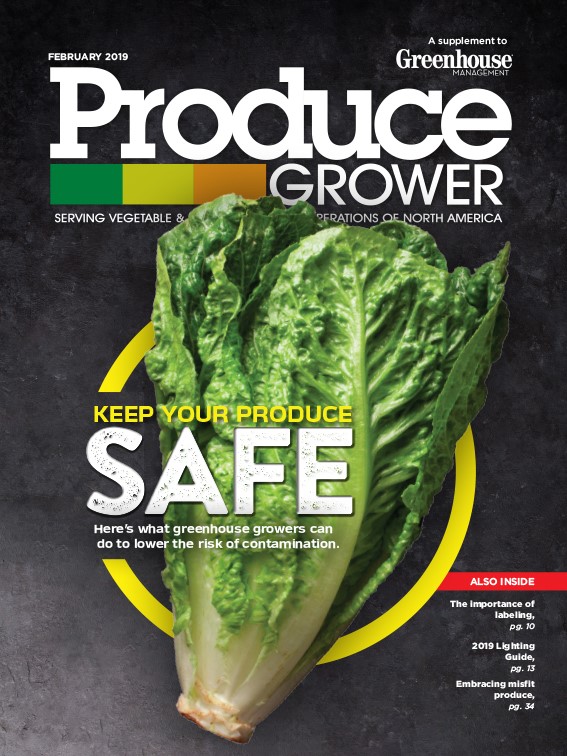

In this first article of a four-part series, researchers from Michigan State University share science-based information about indoor production of leafy greens and herbs.
Before light-emitting diodes (LEDs) became common in the horticulture industry, indoor farmers used fluorescent tubes that emitted a cool- or warm-white light. Nowadays, some indoor farmers are using pink or purple lights, which are comprised of blue (B; 400–500 nm) and red (R; 600–700 nm) LEDs. Other growers are using full-spectrum (or broad-spectrum) lights, which are white LEDs with or without supplemental B, R, and/or far-red (FR; 700–800 nm) LEDs. White LEDs are B LEDs with a phosphor coating, which converts some energetic B photons to longer wavelengths, such as green (G; 500–600 nm) and R. Therefore, full-spectrum LEDs emit more G (and usually FR) light than B+R LEDs.
Plants grow just fine under B+R LEDs, so what does G or FR light bring to the table? Although chlorophylls absorb mainly B+R light, leaves also absorb 70-80% G light. While the upper surface of a leaf absorbs most of the B+R light, G light penetrates deeper into the leaf and gets scattered more to drive photosynthesis. Moreover, G and FR light reach deeper into a canopy than B+R light and can elicit shade-avoidance responses such as increased leaf expansion and upward leaf orientation. As a result, larger leaves intercept more light energy to increase photosynthesis and thus, growth. Green and FR light also contribute to photosynthesis directly.
Although these phenomena indicate positive roles of G light in plant growth, effects of G light have been inconsistent in recent studies. In addition, if G and/or FR light are to supplement B+R light, how G light compares with FR light is unclear. We performed an indoor experiment to determine how partly or completely substituting B light with G and/or FR light affected lettuce and kale growth.
Experimental protocol
We grew green butterhead lettuce ‘Rex,’ red oakleaf lettuce ‘Rouxai,’ and kale ‘Siberian’ in the Controlled-Environment Lighting Laboratory (goo.gl/zM4bDh). Seeds were sown in a rockwool substrate, placed on plastic trays, irrigated with a nutrient solution, and germinated at 68° F under a 24-hour photoperiod from warm-white LEDs at 180 µmol·m-2·s-1 (400–800 nm). On days 9 to 11, seedlings were transplanted into a deep-flow hydroponic system with three vertically stacked layers per rack. Plants were grown at 68° F under a 20-hour photoperiod from each of eight LED lighting treatments at 180 µmol·m-2·s-1 (400–800 nm). The lighting treatments were delivered with the PHYTOFY RL LED fixtures (OSRAM) with seven programmable color channels and software control (Fig. 1). Red light was delivered at 120 µmol·m-2·s-1 in all treatments while the remaining 60 µmol·m-2·s-1 was comprised of B, G, and/or FR light. Blue light at 60 µmol·m-2·s-1 was substituted with G or FR light at 0, 20, 40, or 60 µmol·m-2·s-1. In addition, B, G, and FR light were delivered equally at 20 µmol·m-2·s-1 each (B20G20R20FR20, where numbers indicate photon flux densities in µmol·m-2·s-1). Plants were harvested approximately 30 days after seed sow.


Shoot mass
Substituting G or FR light for B light increased shoot fresh mass of all crops (Fig. 2). Compared with the B60R120 treatment, G60R120 increased fresh mass of lettuce ‘Rex’ by 72%, lettuce ‘Rouxai’ by 79%, and kale ‘Siberian’ by 50%. Compared with B60R120, R120FR60 increased fresh mass of lettuce ‘Rex’ by 37%, lettuce ‘Rouxai’ by 91%, and kale ‘Siberian’ by 43%. Trends for shoot dry mass were generally similar. Shoot mass of all crops under B20G20R120FR20 was comparable to that under B20R120FR40.
Leaf and petiole size
Leaf size increased as B light was substituted with G or FR light. For example, the fifth mature leaves of lettuce and kale were 23–39% longer and 27–34% wider under G60R120 than B60R120 (Fig. 3). In comparison, they were 31–94% longer and 22–50% wider under R120FR60 than B60R120. Leaves were generally longer under FR light than under the same photon flux density of G light for lettuce, but not kale. Substituting 60 µmol·m-2·s-1 of G light for B light increased plant diameter by 38% for lettuce ‘Rex’ and by 86% for lettuce ‘Rouxai.’ In comparison, substituting 60 µmol·m-2·s-1 of FR light for B light increased plant diameter by 32% for lettuce ‘Rex’ and by 63% for lettuce ‘Rouxai.’ Total leaf area and petiole length of kale were measured. Responses of total leaf area were similar to leaf length and width. Although increasing G or FR light (while decreasing B light) increased petiole length, this increase was more pronounced under FR light. Petioles of kale were 26%, 61%, and 68% longer under FR light than G light at 20, 40, and 60 µmol·m-2·s-1, respectively.
Foliage color
Increasing G or FR light (while decreasing B light) decreased an index for chlorophyll concentrations in all crops. At the same photon flux density, FR light decreased it more than G light did. As a result, leaves appeared yellower with increasing G or FR light (and decreasing B light). In addition, the spectrum influenced red foliage coloration of lettuce ‘Rouxai’ (Fig. 2). For example, its foliage became less red and brighter as B light was substituted with G light.
Summary
A partial or complete substitution of B light (as in B60R120) with G or FR light increased harvestable mass and leaf size of lettuce and kale. Increased yields can at least partly be attributed to increased leaf expansion and consequently, light capture for photosynthesis. However, substituting G light for B light decreased foliage redness of red oakleaf lettuce ‘Rouxai.’ Although this study showed apparent benefits of G light in crop growth, it was unclear whether these responses resulted from increasing G light, decreasing B light, or both, which will be addressed in part II of this series. The effects of the light spectrum on other quality characteristics also merit consideration.

Explore the February 2019 Issue
Check out more from this issue and find your next story to read.





